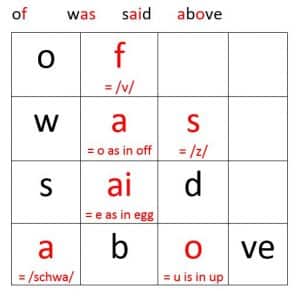A word about sight words
Home » Phonics » Essential principles of systematic and explicit phonics instruction » A word about sight words
What are sight words and do they have a place in early reading instruction? The term ‘sight word’ can be confusing because it is used in numerous ways in the context of teaching reading.
Phonetically irregular (or less regular) words are often referred to as ‘sight words’ because they are difficult for beginning readers to decode using limited phonic knowledge. These are words such as ‘one, ‘was’ or ‘yacht’ and they are usually taught as if they can only be learned as an unanalysed wholes, as word pictures, or as if by ‘sight’. We will refer to them on this page as phonetically irregular words for simplicity, while noting many are decodable once children learn the full phonic code.
High frequency words are lists of words that occur most frequently in English written texts and are often taught as unanalysed whole words, even when they are phonetically regular, such as ‘them’. It is thought that learning high frequency words ‘by sight’ early in the development of reading will accelerate children’s ability to read independently.
Words we recognise instantly. This definition can apply to any word that is recognised immediately as if by ‘sight’, regardless of whether the word is phonetically regular or irregular. Words that are recognised immediately have been orthographically mapped and stored in long-term memory for effortless and rapid retrieval (Ehri 2013). On this page, the term sight word refers to any word that the reader can instantly read in this way.
We learn to read words by connecting them to sound, not their shape
We use our eyes to read so it is logical to think that we recognise words based on visual properties such as word shape, and that this image is directly connected to meaning. Students are often given activities such as boxes to fill in based on word shapes. This is not a good way to teach children learn to read and spell because beginning readers need to make a connection between the visual (the letters) and phonological properties of a word (the way it sounds).
The adult brain does not use global word shape; it still processes the letters but all at once (in parallel). In children, reading requires slow, serial, letter by letter decoding.
Stanislas Dehaene, 'Reading In The Brain'
How we make sense of ‘irregular’ words
What about words that do not follow the usual phonic patterns? Most ‘irregular’ words usually only have one grapheme-phoneme correspondence that does not follow the usual rules. Consider the words ‘of’, ‘was’, ‘said’ and ‘above’ and how they can be ‘mapped’ utilising knowledge of more regular letter-sound correspondences.
The ability to notice and utilise the stable letter-sound correspondences in these words help us to create a “phonological framework”, and we then note the irregular grapheme-phoneme correspondence in the word. This singular irregularity is then remembered for future encounters. A partial decoding is often enough to get the reader close to the correct pronunciation so they can retrieve it from their spoken vocabulary. This is called ‘set for variability’ or ‘mispronunciation correction’. Multiple research studies have demonstrated that this is what readers do when they encounter a new phonetically ‘irregular’ word (Ehri, 2005; Frost, 1998; Katz & Frost, 2001; Share, 1995; Van Orden & Kloos, 2005).
How to include high frequency and phonetically irregular words in early reading instruction
Some phonics advocates believe that teaching children even a small number of words as unanalysed wholes may lead to confusion about letter-sound mappings and instil bad reading habits, but research evidence does not support this idea. McArthur et al. (2015) found that students who received phonics instruction combined with sight word training made equivalent gains to students who received phonics instruction only. Shapiro and Solity (2016) made similar findings with a typical group of children. Sight word learning is more likely to be successful when children have some degree of basic letter knowledge but the minimum level of alphabetic skill for sight word learning to be effective is still unknown.
A review of literature found that teaching children to use mispronunciation correction strategies was effective for reading unfamiliar irregular words (Colenbrander et al., 2021). Two recent studies of mispronunciation correction confirmed this finding (Colenbrander et al, 2022; Steacy et al., 2022).
So what are best methods of teaching high frequency and phonetically irregular words? Activities focusing on the shape of the word, or trying to remember words as unanalysed wholes are not a good investment in instructional time. From what research has shown about orthographic mapping it makes sense to study the parts of the words that are regular whilst noting any difficult parts and linking these to the pronunciation of the word. This is in keeping with the research on word recognition.
Teaching grapheme-phoneme correspondences is essential, however. In beginning reading instruction, where readers have been exposed to only a small number of letter-sound correspondences, teaching a small number of carefully selected high frequency words can be helpful to get children on the path to successful reading, especially with decodable books.



